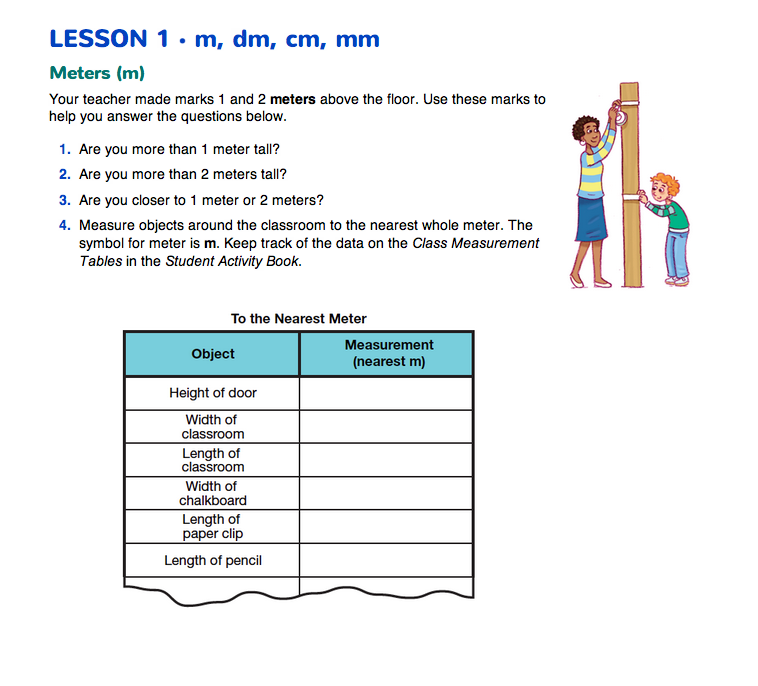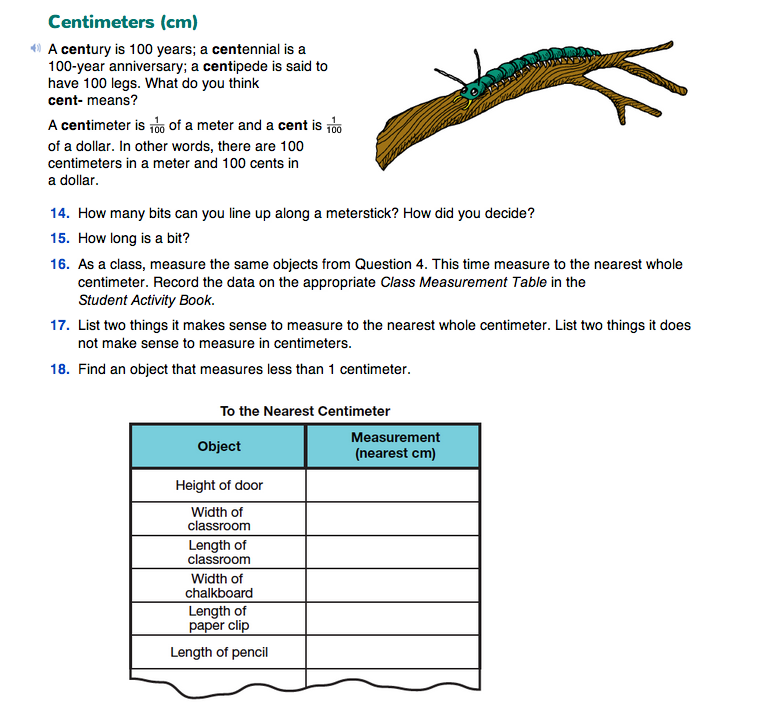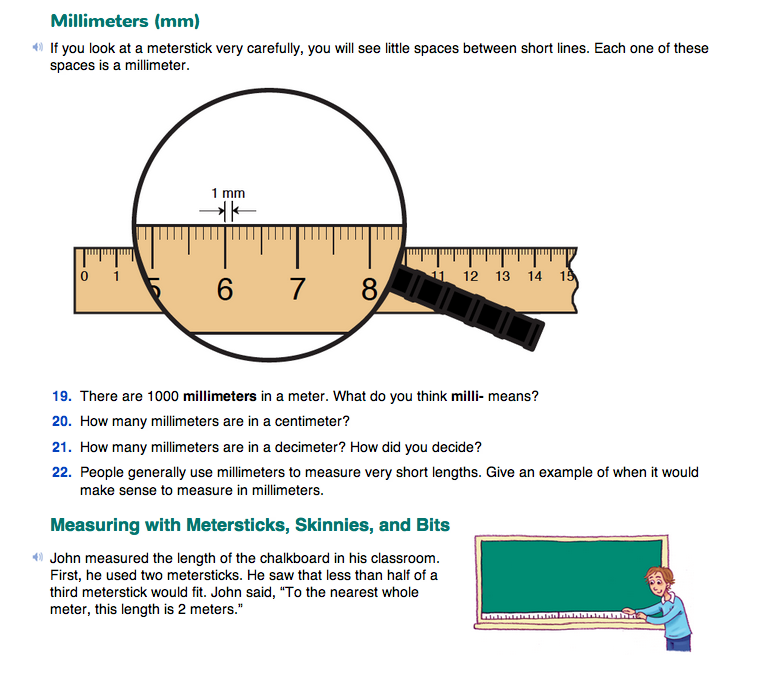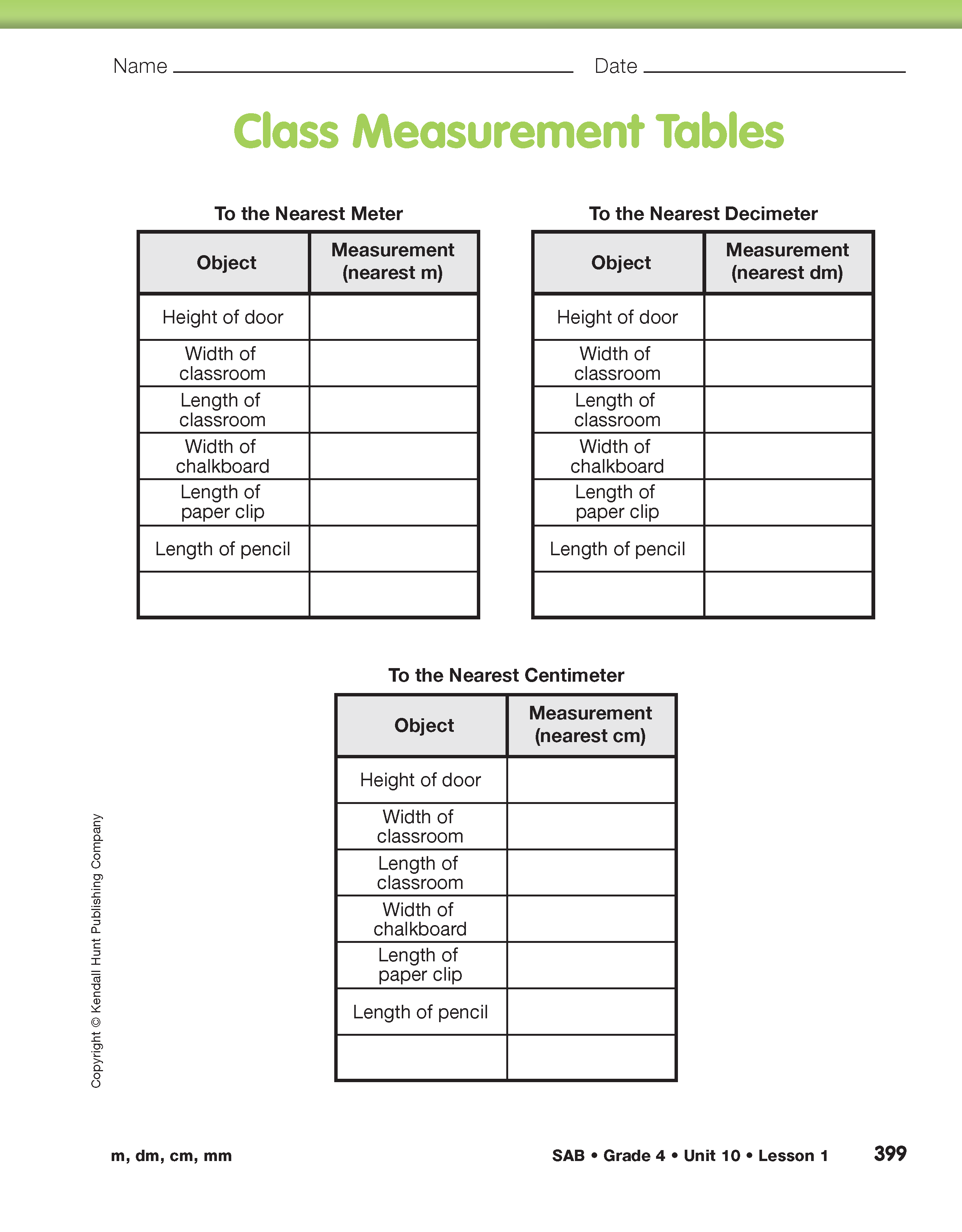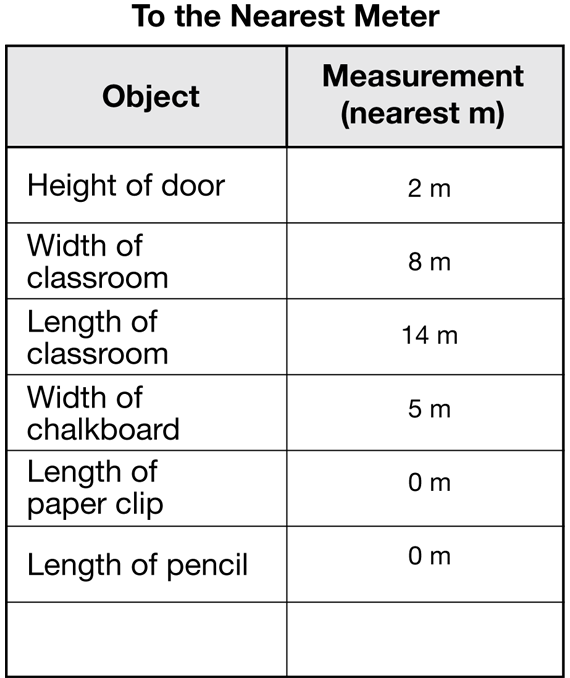This activity leads students through measuring the same objects several times with progressively smaller units. Students are led to see that it is important to choose the appropriate unit of measure in order for the measurement to make sense or to be useful (e.g., miles from Chicago to Paducah, feet for the length of a living room).
Measure in Meters. The Meters (m) section of the m, dm, cm, mm pages in the Student Guide introduces the notion of measuring to the nearest meter. Questions 1–3 help students visualize a meter.
In Question 4, the class measures a variety of classroom objects to the nearest whole meter. Students record measurements on the Class Measurement Tables page in the Student Activity Book. Collect measurements on a chart or display of the page. See Figure 1. Note that the length of a paper clip is 0 m long to the nearest meter since it is less than a half meter.
In later parts of this activity, these same objects will be measured using smaller units. Displays of the different data tables should be used each time instead of adding columns to the first table. If the measurement for height of a door is recorded as 2 meters and then recorded as 19 decimeters in the same table, students may mistakenly think the height is 2 meters 19 decimeters.
To avoid having students group around certain objects or having students wandering looking for objects to measure, make a list of classroom objects that students can measure. Assign groups of students to measure certain objects.
In Questions 5–7, students discuss using an appropriate unit of measure. They measure the length of a calculator to the nearest whole meter (0 m) and find that such a measurement does not give useful information.
Measure in Decimeters. Questions 8–10 ask students to explore the decimeter by lining up skinnies along a meterstick.
- If a decimeter is one-tenth, then what is one whole? (Ten decimeters make a meter.)
- If a skinny is one-tenth of a whole unit, what base-ten piece represents the whole? (Ten skinnies make a flat. The flat is the whole.)
The decimeter is a metric unit that is not commonly used in the United States. We include it here for completeness and because sometimes it is the best unit to use. The centimeter is more commonly used for small lengths; however, even whole centimeters are too large for tiny lengths like the thickness of a penny, the thickness of a piece of hair, or the thickness of a compact disc. For these we use millimeters or even smaller units.
Question 11 asks students to remeasure the objects they measured to the nearest meter, but this time they measure to the nearest decimeter using metersticks and skinnies. Students record their data in the appropriate data table on the Class Measurement Tables page from the Student Activity Book.
- With which objects did it make sense to use a meter to measure? Why? (The width and length of the classroom, because those measurements are much longer than a meter, so it was easiest to use the largest unit of measure.)
- Why was the meter better for these measurements than the decimeter (the skinny)? (When we measured with the skinny, we had to place it end-to-end many times and it was easy to lose count and to not measure exactly.)
- Which objects were easier to measure using the decimeter (skinny)? Why? (The chalkboard and the pencil, because they were smaller. We didn't have to put so many skinnies end-to-end.)
In Questions 12 and 13, students discuss appropriate times to measure with decimeters.
Assign Questions 1–2 in the Homework section of the m, dm, cm, mm pages in the Student Guide. These activities will help students develop an intuitive sense of the metric system and the length of a meter. Students can use their meter-length strings or regular metersticks to measure.
Measure Centimeters. Ask students to explore centimeters by discussing the introduction in the Centimeters (cm) section of the m, dm, cm, mm pages in the Student Guide and by answering Questions 14 and 15.
Question 16 asks students to remeasure objects to the nearest centimeter. Use Questions 17 and 18 to discuss when it makes sense to do that.
- What object do you think of when I ask how long a centimeter is? (Possible responses: a pea, a bit, the width of my little finger)
- When would it make sense to measure in centimeters? (Possible responses: Use centimeters to measure the length of a marker, an apple, or a stapler.)
Measure in Millimeters. Assign and discuss Questions 19–22 in the Millimeter (mm) section.
- Why are you not asked to measure objects in your data tables to the nearest millimeter? (It would be difficult to measure accurately. In most cases, it's not necessary to measure large objects to the nearest millimeter.)
- When would it make sense to measure in millimeters? (Possible answers: Measure in millimeters when an object is very small. You could measure the width of a penny, the length of an ant, the width of a strand of hair, or the width of a needle in millimeters.)
Another way to foster number sense about length is to identify reference lengths for different units of measure. For example, when students think of a meter, they can think of the distance between the floor and a doorknob. Ask:
- What object do you think of when I say, “How long is a centimeter?”
- A millimeter?
- A decimeter?
- A meter?
Ideas for “unit reference lengths” can be listed on a bulletin board.














